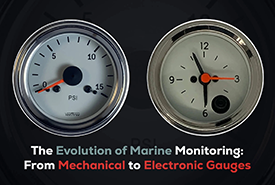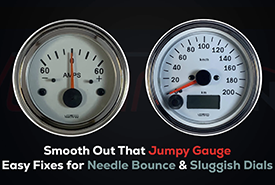- Free shipping for NZ Customers. All items are available in NZ warehouse
- +64 (0) 212576146
- [email protected]
Making the Right Connections: Decoding the Selection Process for Switch Gauges

The Power of Maintenance: Keeping Automotive, Marine, and Industrial Measuring Instruments Shipshape!
May 25, 2023
5 Quick Tips for Seamlessly Installing Trim Gauges on Your Boat in 2023
August 7, 2023Switch gauges are essential instruments used for measuring various parameters in different industries. Whether you're working in manufacturing, automotive, or any other field that requires accurate measurements, choosing the right switch gauge is crucial. With so many options available in the market, it can be overwhelming to make a decision. This article aims to guide you through the process of selecting the perfect switch gauges for your specific needs.
Understanding Switch Gauges
Before diving into the selection process, it's important to understand what switch gauges are and how they work. Switch gauges, also known as pressure or temperature switches, are instruments designed to provide a binary output based on a specific threshold. They are capable of indicating when a certain value is reached or crossed, triggering an electrical signal or actuating a relay.
Switch gauges are available in different types, including electromechanical and solid-state variants. Electromechanical switch gauges utilise mechanical components like diaphragms or Bourdon tubes, while solid-state switch gauges rely on semiconductor technology to sense and interpret measurements.
Factors to Consider When Choosing Switch GaugesTo choose the right switch gauge for your needs, it's important to evaluate several key factors. Here are the most significant considerations:
- Accuracy and Precision: The accuracy and precision of the switch gauge are crucial, especially in critical applications. Ensure that the gauge you select offers the required level of accuracy for your measurements.
- Measurement Range: Consider the measurement range of the switch gauge. It should cover the entire span of values you need to monitor.
- Environmental Conditions: Take into account the environmental conditions in which the switch gauge will operate. Factors like temperature, pressure, humidity, and exposure to chemicals can impact the gauge's performance and longevity.
- Display and Readability: Consider the readability of the gauge's display. It should be clear and easy to interpret, even from a distance. Features like backlighting and digital displays can enhance visibility.
- Compatibility with Existing Systems: If you have an existing control or monitoring system in place, ensure that the switch gauge is compatible with it. Check for compatibility with communication protocols and electrical connections.
- Cost Considerations: Evaluate the cost of the switch gauge, keeping in mind your budget and the value it offers. Remember that quality and reliability are important factors that may justify a higher price.
Switch gauges are available in different types, each with its own advantages and limitations. Understanding the types will help you make an informed decision. The three primary types of switch gauges are:
- Analog Switch Gauges: Analog switch gauges utilise traditional mechanical components and offer a visual indication of measurements through a dial or needle. They are often preferred for their simplicity and durability.
- Digital Switch Gauges: Digital switch gauges provide numerical readouts and offer greater precision and accuracy. They often come with advanced features like data logging and programmable set points.
- Combination Switch Gauges: Combination switch gauges integrate analogy and digital displays, providing the benefits of both. They offer the convenience of digital readouts alongside the visual simplicity of analogy displays.
Determining the Right Switch Gauge for Your Needs
To determine the right switch gauge for your needs, follow these steps:
- Identify Your Specific Requirements: Understand the parameters you need to measure, the required accuracy, and the environmental conditions.
- Consider the Application and Industry: Different industries have specific requirements. Consider industry standards and regulations that may affect your choice.
- Consult with Experts or Manufacturers: Reach out to experts or manufacturers in the field to seek advice and gather insights about suitable switch gauges for your application.
- Evaluate the Gauge's Features and Specifications: Carefully review the features, specifications, and technical datasheets of the switch gauges you're considering. Pay attention to factors such as pressure or temperature ratings, response time, and electrical connections.
- Read Customer Reviews and Ratings: Seek feedback from other users or customers who have experience with the switch gauges you're interested in. Their reviews can provide valuable insights into real-world performance and reliability.
Installation and Maintenance Tips
Once you have chosen the right switch gauge, proper installation and maintenance are essential for optimal performance. Here are some tips to keep in mind:
- Proper Installation Procedures: Follow the manufacturer's guidelines for installation, ensuring correct wiring, mounting, and sealing techniques.
- Regular Maintenance and Calibration: Regularly inspect and clean the switch gauge to prevent dirt or debris from affecting its performance. Calibrate the gauge as recommended by the manufacturer or industry standards.
- Troubleshooting Common Issues: Familiarise yourself with common issues that may arise with switch gauges, such as incorrect readings or failure to actuate. Troubleshoot these issues or seek professional assistance when needed.
Finally,
Choosing the right switch gauge is crucial for accurate measurements, efficient operations, and equipment protection. By considering factors like accuracy, measurement range, environmental conditions, compatibility, and cost, you can make an informed decision.
Remember to consult with experts, evaluate specifications, and read customer reviews. Proper installation, maintenance, and troubleshooting will ensure the switch gauge performs optimally throughout its lifespan.
Select wisely and enjoy the benefits of reliable measurements and control. Or you contact us to get help in choosing the right Switch gauge for your application.




